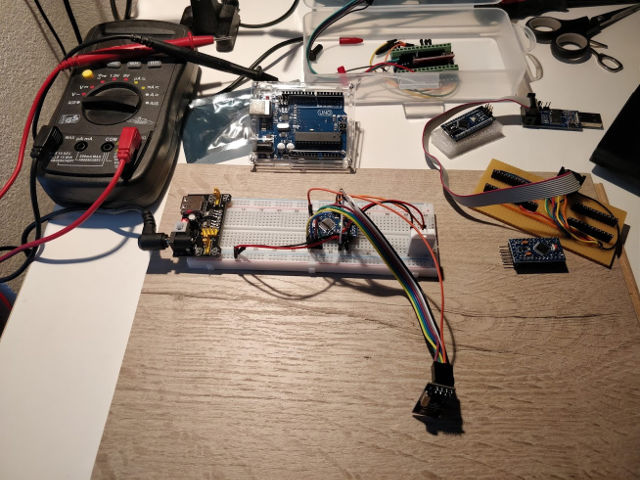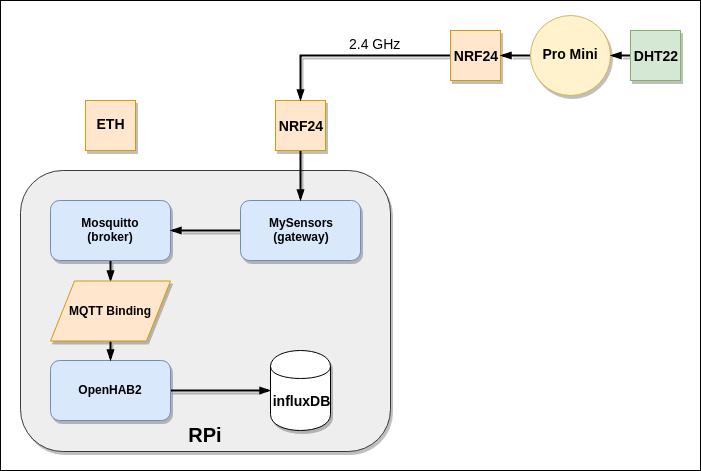my first sensor is a DHT22 (temperature/humidity, very good accuracy), attached to a 3.3V pro mini (ATMEGA 328p), connected via a NRF24 l 01+ (2.4GHz) which is capable of low-power transmission. This enables the arduino to later work on battery power only. My goal is to build three of these sensors. The assembly is straight forward:

I had many setbacks, connecting the sensor to the Raspberry Pi, though. This forced me to understand how a basic MQTT infrastructure has to interact with its data sources and OpenHAB2:

Steps to connect:
- add node ID and parent ID to sketch
- define lower baud rate for later running the board at a lowered clock speed
- get MySensors Gateway working on RPi
- Connect GateWay to Mosquitto
- Connect Mosquitto to the OpenHAB MQTT binding
Step by step
Following the basic steps in more detail. Keep in mind that starting with OpenHAB2, the “old” bindings like MQTT are not shown in PaperUI, even when installed. So you’d have to configure all items manually (which took me a few hours to find out)!
Sensor IDs and baud settings in sketch
#define MY_NODE_ID 101
#define MY_PARENT_NODE_ID 0
// Define a lower baud rate for Arduino's running on 8 MHz (Arduino Pro Mini 3.3V & SenseBender)
#if F_CPU == 8000000L
#define MY_BAUD_RATE 9600
#endifI’ve set up my sensor node IDs in “namespaces” like that:
- 1xx environmental sensor nodes
- 2xx extra nodes like elecrity IR reader
Attaching the NRF24 is relatively straight forward, as is connecting the DHT22.
Install and configure mosquitto
The current version, provided by apt is 1.4.x - I only managed to get it running in a stable manner when using 1.5.
- name: Add mosquitto repository
apt_key:
url: http://repo.mosquitto.org/debian/mosquitto-repo.gpg.key
state: present
- apt_repository:
repo: "deb https://repo.mosquitto.org/debian stretch main"
update_cache: True
state: present
- name: install packages
apt: pkg={{item}} state=latest
with_items:
- mosquitto
- mosquitto-clientsInstall MySensors gateway
In hindsight this is quite easy. Most of the time I needed, went into a reproducable ansible script ;-) You can find instructions here. Since I won’t be exposing my OpenHAB instance to the internet - only available via VPN - I will not introduce authentication.
So, follow the instructions and install/compile the gateway. Keep in mind, that you will need mosquitto installed, too. I’d also opt for the MQTT binding for OpenHAB, since it’s working fine with mosquitto. You can use the defaults @ mosquitto.
Some ansible help:
- name: get mysensors mqtt repo
git:
repo: https://github.com/mysensors/MySensors.git
dest: /home/pi/MySensors
accept_hostkey: yes
version: master
- name: configure
command: "./configure --my-transport=nrf24 --my-gateway=mqtt --my-controller-ip-address=127.0.0.1 --my-mqtt-publish-topic-prefix=mysensors-out --my-mqtt-subscribe-topic-prefix=mysensors-in --my-mqtt-client-id=mysensors-gateway"
args:
chdir: /home/pi/MySensors
- name: copy mysensors config
template: src=./mysensors.conf.j2 dest=/etc/mysensors.conf owner=root group=root mode=755
- name: make
command: "make"
args:
chdir: /home/pi/MySensors
- name: install
command: "make install"
args:
chdir: /home/pi/MySensors
notify:
- start mysqwIt’s that easy, since all components reside within the RPi. Don’t forget to attach a NRF24 to your RPi aswell!
Install the MQTT binding and influxdb
Two parts: Install influxdb and client and manually install the bindings in OpenHAB.
- name: Add influxdb apt key
apt_key:
url: https://repos.influxdata.com/influxdb.key
state: present
- apt_repository:
repo: "deb https://repos.influxdata.com/debian stretch stable"
update_cache: True
state: present
- name: install base packages
apt: pkg={{item}} state=latest
with_items:
- influxdb
- influxdb-client
notify:
- start influxdbFor influxdb, use the defaults provided here. Don’t forget to configure persistence for OpenHAB (influxdb.persist)!
Strategies { default = everyChange }
Items { * : strategy = everyUpdate, restoreOnStartup }
Configure OpenHAB
I installed OpenHAB as a package, so no OpenHABbian.
This means: All configuration resides in /etc/openhab2
I strongly(!!!) suggest you to pack the whole directory into a separate git repository! You will configure a lot via config files and since PaperUI persists only in json files, which most of the times are generated from the config files, the latter are the safer bet.
services/mqtt.cfg:
mosquitto.url=tcp://localhost:1883
mosquitto.clientId=openhab
mosquitto.qos=1
mosquitto.retain=true
mosquitto.async=false
services/mqtt-eventbus.cfg:
broker=mosquitto
stateSubscribeTopic=mosquitto/stateUpdates/${item}/state
commandSubscribeTopic=mosquitto/commandUpdates/${item}/command
items/dht22.items:
Group Home "home" <house>
Group GF "Ground Floor" <groundfloor> (Home)
Group FF "First Floor" <firstfloor> (Home)
Group F2 "Second Floor" <attic> (Home)
Group F3 "Third Floor" <attic> (Home)
Group GF_Cellar "Cellar" <cellar> (Home, GF)
Group FF_LivingDining "Living & Dining Room" <sofa> (Home, FF)
Group F2_Bedroom "Bedroom" <bedroom> (Home, F2)
Group F2_KidsRoom "Kids Room" <girl_3> (Home, F2)
Group F3_GuestRoom "Guest Room" <parents_4_3> (Home, F3)
Number DHT22_101_01_cellar_temp "temperature [%.1f °C]" <temperature> (gTemperature, GF_Cellar) {mqtt="<[mosquitto:mysensors-out/101/1/1/0/0:state:default]"}
Number DHT22_101_02_cellar_hum "humidity [%.1f %%]" <humidity> (gHumidity, GF_Cellar) {mqtt="<[mosquitto:mysensors-out/101/0/1/0/1:state:default]"}
Group:Number:AVG gTemperature "Temperature" <temperature> (Home)
Group:Number:AVG gHumidity "Humidity" <humidity> (Home)
That’s a lot in the items but mostly it’s auto-generated grouping. The really interesting lines are the ones starting with “Number”. They actually handle the processing of incoming sensor values for the temp/hum DHT22 sensor. Addotional sensor definitions (for DHT22s) would be located in here, too.
If you’ve followed this guide, you should have a working sensor with MySensors framework communicating with a RPi, having a MQTT gateway, broker and binding, pushing data into an influxdb.